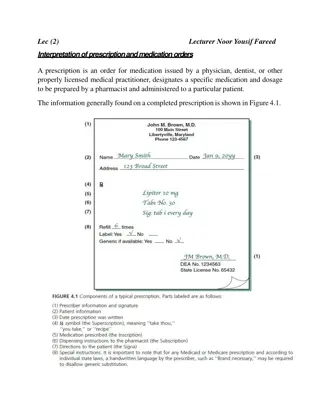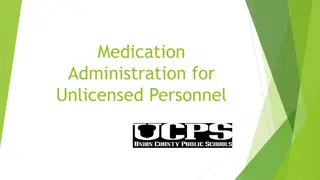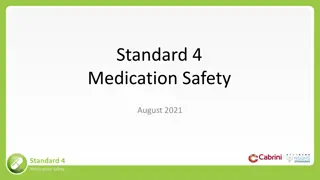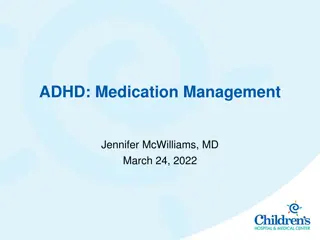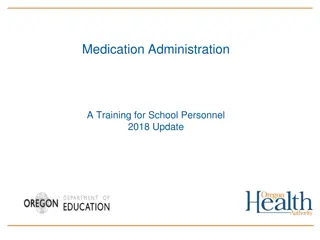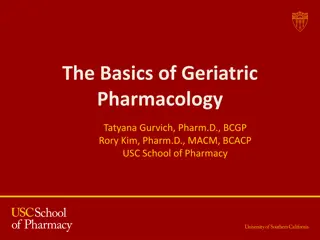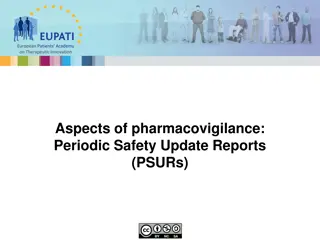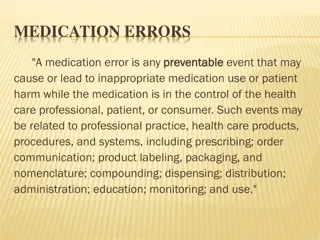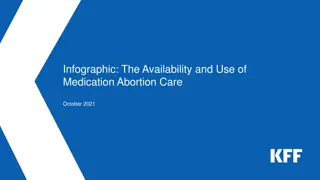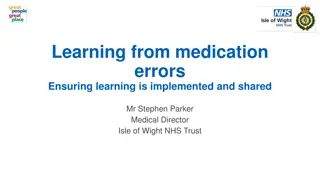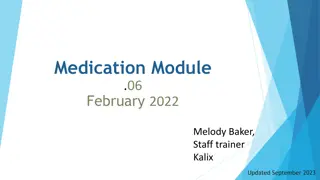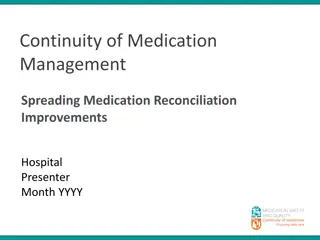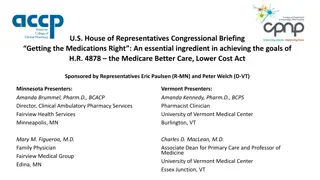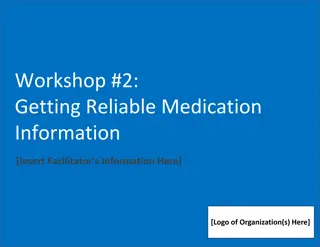Medication Errors in Pharmacovigilance Centers
Adverse drug reactions resulting from medication errors are a significant concern faced by pharmacovigilance centers. This content discusses the importance of this problem, contributing factors, the relevance to pharmacovigilance centers, and strategies for managing medication errors. It highlights the definitions of adverse drug reactions, medication errors, and preventable adverse drug reactions, emphasizing the need for vigilance in the treatment process to prevent harm to patients. Various contributing factors, including healthcare professionals, risk evaluation, patient factors, and education, are discussed, along with the magnitude of the issue and reasons for medication-related harm. Understanding these factors is crucial for developing effective risk management plans and improving patient safety in healthcare settings.
Download Presentation

Please find below an Image/Link to download the presentation.
The content on the website is provided AS IS for your information and personal use only. It may not be sold, licensed, or shared on other websites without obtaining consent from the author.If you encounter any issues during the download, it is possible that the publisher has removed the file from their server.
You are allowed to download the files provided on this website for personal or commercial use, subject to the condition that they are used lawfully. All files are the property of their respective owners.
The content on the website is provided AS IS for your information and personal use only. It may not be sold, licensed, or shared on other websites without obtaining consent from the author.
E N D
Presentation Transcript
Medication errors within PV Centers Pr. Rachida Soulaymani Bencheikh Centre Anti Poison et de Pharmacovigilance du Maroc WHO Collaborating Centre Rabat for Strengthening Pharmacovigilance Practices Bogota, October 2019
Content 1. How important is the problem ? 2. What are the contributing factors ? 3. Why should PV centers be interested in ME ? 4. How to manage ME ?
Definition Adverse Drug Reactions ADRs Noxious and unintended effect resulting not only from the authorized use of a medicinal product at normal doses, but also from medication errors and uses outside the terms of the marketing authorization, including the misuse and abuse of the medicinal product Directive 2010/84/EU of the European Parliament and of the Council
Definition Medication Error An unintended failure in the treatment process that leads to, or has the potential to lead to harm to the patient Ferner & Aronson Lancet 2000: 355(9208): 947 8 Preventable Adverse Drug Reaction An injury that is the result of an error at any stage of the treatment process Consensus during the Delphi survey
Magnitude of the problem Adverse drug reactions are a reality They have been well known for a long time now Drugs carry a risk factor that can compromise individual of collective health
Why does harm happen ? Drug is Active substance Substance foreign to the body Irrational/Inappropriate use of drugs
Contributory Factors Health care Professionals Risk Evaluation Quality Patient Intrinsic activity Socio-economic level Raw materials Education Principal effect Spontaneous reports Preclinical and clinical trials and post marketing studies Generics and biosimilars Marketing authorisation procedure Secondary effect SMR Implication Background Countrefeit substandard Pharmaco - pid miology Risk Factors Workload Adverse Event Drug Misuse Organization Transparency Previous sensitization Conventional circuit Pharmaco- dependance Decison making Therapeutic protocols Information, communication Ovedose Allergen properties Hors Circuit conventionnel Media coverage Risk management plan Strategy Medication error Risk Distribution and storage Immunological effect Ways of use Health system Management
Widening scope of Pharmacovigilance ` Shift in focus From drug safety to patient safety
Since 1963 Pharmacovigilance scope has widened From ADR related to medicines in normal use To A Variety of ADR situations related to multiple Health Products Creation of multiple Vigilance systems, under multiple structures
Pharmacovigilance Context/Circumstances Medicinal products Normal conditions of use Medication errors Treatment failure Drug-drug interactions Pregnancy and lactation Dependance Resistance Abuse, misuse Intoxications Toxicomany Defective products or counterfeit products Medicines, vaccines and combined oral contraceptives Diagnostic radiology products Biological products Medical devices Dietary products and food additives Herbals Homeopathic products Cosmetics products Veterinary products Period Statut Clinical trials Post Marketing Legal circuit Illegal circuit
Duplicating systems lead to Staff and budget consuming Divergence of terms and definitions Conception and production of multiple reporting forms Development of variety of methods for the same purposes causality assessment preventability methods root cause analysis specific databases where cross analysis is not always possible Confusion for reporters Lack of coordination Risks of overlaps and redundancies Lack of cross-learning between systems
Organizations with related terms and definitions on their website N Institute for Healthcare Improvement (IHI): USA N Institute for Safe Medication Practices (ISMP): USA N Institute of Medicine (IOM): USA N Joint Commission on Accreditation of Healthcare Organisations (JCAHO): USA N National Academy for State Health Policy (NASHP): USA N National Association of Public Hospitals and Health Systems (NAPH): USA N National Center for Patient Safety (NCPS): USA N National Committee for Quality Assurance (NCQA): USA N National Coordinating Council for Medication Error Reporting and Prevention (NCCMERP): USA N National Patient Safety Agency (NPSA): UK N New South Wales Therapeutic Advisory Group (NSW TAG): Australia N Northern Sydney Health (NSH): Australia N Quality Interagency Coordination Task Force (QuIC): US N The Royal College of Physicians and Surgeons of Canada (RCPSC): Canada N United Kingdom Department of Health: UK N Victorian Drug Usage and Advisory Committee (VDUAC): Australia World Health Organisation (WHO): International Adverse Drug Reaction Advisory Committee (ADRAC):Australia N Agency for Healthcare Research and Quality (AHRQ): US N American Society of Consultant Pharmacists (ASCP): USA N American Society of Healthcare Risk Management (ASHRM):USA N American Society of Health-system Pharmacists (ASHP):USA N Association of Perioperative Registered Nurses (AORN):USA N Australian Capital Territory Health (ACT Health): Australia N Australian Council for Safety and Quality in Health Care (ACSQHC): Australia N Australian Patient Safety Foundation (APSF): Australia N British Medical Association (BMA): UK N Canadian Institute for Health Information (CIHI): Canada N Commission for Healthcare Improvement (CHI): UK N Commonwealth Department of Health and Aging:Australia N ECRI (formerly the Emergency Care Research Institute):USA Food and Drug Administration (FDA): USA N Health Canada: Canada 160 Organizations
Number of terms and corresponding definitions Number of definitions (total) Number of definitions (total) Terms Terms Adverse drug event Adverse drug reaction Adverse effect Adverse event Adverse incident Adverse medication event Adverse reaction Critical event Critical incident Error Incident Medical error Medication error 10 11 1 21 2 1 3 1 1 13 8 3 7 Medication incident Near miss Potential adverse drug event Potential adverse event Potential error Preventable adverse drug event Preventable adverse event Sentinel event Serious adverse event Side effect Significant adverse event Unpreventable adverse event 1 8 4 1 3 2 2 5 2 6 1 2 Total of 119 definitions for 25 terms :
A global system : Advantages Sharing tasks and tools reduce human and financial needs One stop shop for the reporter reduce problem of underreporting Global database earlier detection of signals to risk minimization Sharing expertise and cross learning
WHO Guideline Objectives Increase the capacity of national PVC to identify and analyse preventable ME Stimulate cooperation between national PVC and the World Alliance for Patient Safety Guidelines intended for Pharmacovigilance Centres Medication Safety Organizations Patient Safety Organizations Health professonals
Increase the capacity of national PVC to identify and analyse preventable ME Collect and Identify preventable Adverse Drug Reactions (ADRs) and medication errors(ME) Analyze preventable ADRs and ME reports Put in place actions to minimize the risk of occurrence of preventable ADRs and ME
Collect and Identify preventable ADRs and ME Common Terminologies - taxonomies - procedures Integrated vigilances Common reporting form An integrated information system Tools for Data Management Training and capacity building
Standard reporting form Needs 5 Blocks Patient (report Id) AE/Incident Medicinal product: suspected and concomittent Context /circumstances Reporter (to have more information)
Variable Data (1) Health Products Common Items Name: Brand name and INN Indication/ reason for use Dose - Route Duration : Start and stop date Action taken Medicines, vaccines and combined oral contraceptives Diagnostic radiology products Biological products Medical devices Dietary products and food additives Herbals Homeopathic products Cosmetics products Veterinary products
Variable Data (2) Context /circumstances Normal conditions of use Medication errors Treatment failure Drug-drug interactions Dependence Resistance Abuse, misuse Poisoning Toxicomany Defective products or counterfeit products
Going beyond classic PV PV centres need to adapt classic PV tools and methods to manage ME within PV centres Expand the role of PV centres to the detection and the management of ME Needs to develop new tools for analyzing Preventability method: ME classification, Root Cause Analysis
Preventability Assessement Preventability Preventability implies that methods for averting a given injury are known and that an adverse event, results from failure to apply that knowledge Leape, 1993 Preventable What can be avoided by the implementation of appropriate measures Preventable Adverse Drug Reaction An injury that is the result of an error at any stage of the treatment process
Preventability Assessement Tool to detect pADRS: The P Method 24
Preventability Method The P Method Preventability Method concept Allows systematic detection of ME and any irrational use of drugs, within ADRs reported to PVCs Based on the identification of any well known preventablerisk factors that increases the likelihood of ADRs occurrence : 20 defined preventability criteria. Risk factors are related to HCP Practices Patient behavior Product quality Result of the method assessment: Preventable: at least one preventability criteria is identified Non preventable: none of the preventability criteria is identified Not assessable: there is insufficient data for preventability assessment 25
Preventable and Non Preventable ADR NOT FROZEN Statement Closely linked to how drug is used and monitored Depends on: Time, space Current state of knowledge on mechanism of ADR occurrence Capacity of health services in developing therapeutic protocols and making tools and analysis for reducing the occurrence of ADR Then, a Non preventable ADR may, in future, become a preventable ADR Non preventable ADR in a country may be stated as a preventable ADR in another one 26
Role of Pharmacovigilance centres PVC s are in the heart of clinical practice, Public Health and Patient Safety Promotion Adverse reaction are the entry point for PV practices Capacity building of PV professionals should focus on how AR s (risk for the patient and for the population) can be managed in order to: To diagnose professionally the AE s as a patient clinical state (risk identification) To understand how and why it happened (risk management) To anticipate de risk in order to avoid it occurrence (risk minimisation)
Pharmacovigilance towards maturity 50 s and 60 s: from nothing to reacting late 70 s: foundation of Pharmacovigilance principles 80 s to 90 s : From reacting late to reacting earlier 2000 s : Getting proactive and fast reacting toward risks


